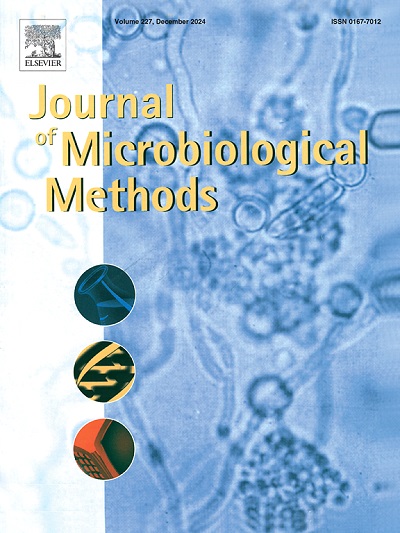"利用基于 Cas9 的共轭载体固化革兰氏阴性菌中的常见质粒"。
IF 1.9
4区 生物学
Q4 BIOCHEMICAL RESEARCH METHODS
引用次数: 0
摘要
我们报告了利用 CRISPR-Cas9 系统创建的 17 个携带共轭质粒 pLCasCureT 的大肠杆菌菌株,通过手术 "治愈 "了肠杆菌属物种中最常见的质粒。这种方法可以创建同源菌株对,用于研究宿主与质粒的相互作用、质粒基因型与表型的相关性,以及创建无质粒克隆菌株。本文章由计算机程序翻译,如有差异,请以英文原文为准。
“Curing of common plasmids in gram-negative bacteria using a Cas9-based conjugative vector”
We report the creation of 17 Escherichia coli strains harboring the conjugative plasmid pLCasCureT with a CRISPR-Cas9 system to surgically “cure” the most common plasmids among Enterobacterales species. This approach can create isogenic pairs of strains to study host-plasmid interactions, correlate plasmid genotype and phenotype, and create plasmid-free cloning strains.
求助全文
通过发布文献求助,成功后即可免费获取论文全文。
去求助
来源期刊

Journal of microbiological methods
生物-生化研究方法
CiteScore
4.30
自引率
4.50%
发文量
151
审稿时长
29 days
期刊介绍:
The Journal of Microbiological Methods publishes scholarly and original articles, notes and review articles. These articles must include novel and/or state-of-the-art methods, or significant improvements to existing methods. Novel and innovative applications of current methods that are validated and useful will also be published. JMM strives for scholarship, innovation and excellence. This demands scientific rigour, the best available methods and technologies, correctly replicated experiments/tests, the inclusion of proper controls, calibrations, and the correct statistical analysis. The presentation of the data must support the interpretation of the method/approach.
All aspects of microbiology are covered, except virology. These include agricultural microbiology, applied and environmental microbiology, bioassays, bioinformatics, biotechnology, biochemical microbiology, clinical microbiology, diagnostics, food monitoring and quality control microbiology, microbial genetics and genomics, geomicrobiology, microbiome methods regardless of habitat, high through-put sequencing methods and analysis, microbial pathogenesis and host responses, metabolomics, metagenomics, metaproteomics, microbial ecology and diversity, microbial physiology, microbial ultra-structure, microscopic and imaging methods, molecular microbiology, mycology, novel mathematical microbiology and modelling, parasitology, plant-microbe interactions, protein markers/profiles, proteomics, pyrosequencing, public health microbiology, radioisotopes applied to microbiology, robotics applied to microbiological methods,rumen microbiology, microbiological methods for space missions and extreme environments, sampling methods and samplers, soil and sediment microbiology, transcriptomics, veterinary microbiology, sero-diagnostics and typing/identification.
 求助内容:
求助内容: 应助结果提醒方式:
应助结果提醒方式:


